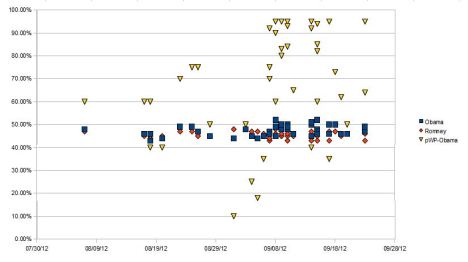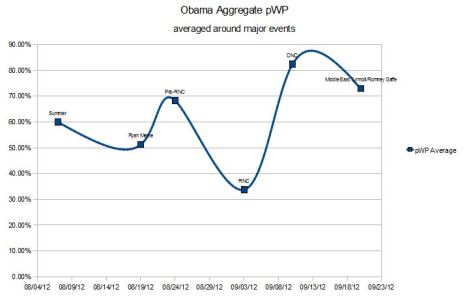There has been a meme spreading among conservative commentators that pollsters are getting their models entirely wrong when it comes to predicting the actual breakdown of voters in the upcoming election. It’s an interesting thesis, and one we can attempt to analyze using pWP as a test.
Any use of statistics must involve some kind of logical framework, a qualitative analysis, or else you’re just data mining (data mining is bad because random patterns will emerge in large data sets purely by chance). So what is our qualitative analysis of the 2012 presidential election? Do we, based on our experiences with past elections and our knowledge of the two candidates, think this election is basically an automatic win for one side or the other?
No, of course not. We know what those races look like. At least, those of us who remember Bob Dole do. We can say with confidence, without using any polls or census data whatsoever, that Keith Ellison will win re-election. The same goes for Nancy Pelosi, the same goes for many matchups that are basically decided long before anyone starts campaigning (excepting tail-events).
The current presidential election is not one of these races, unless you’re a mesmerized partisan. This knowledge in hand, we can look at pWP to help us find those polls that appear to be outliers because they suggest one candidate or another has a substantial lead (probability of winning) far beyond what our qualitative analysis would predict.
In the following graph, I have divided up all the polls taken since Romney picked Paul Ryan as his running mate into five categories based on pWP. Any poll that has a result of 90% or higher is an outlier. Any poll between 40% and 60% pWP is a tossup, and the rest all lean either Obama or Romney.
As everyone can see, there are a lot more outliers for Obama than Romney. But it should be noted, most of Obama’s outliers are clustered around the convention, and Romney’s outlier also dates to his convention. Still, at least three polls recently have been outliers for Obama, depending on the arbitrary point where decide “positive convention coverage” ended. If we remove the outliers and look just at the polls working within our qualitative framework, Obama is still looking good. If you split the tossup polls, and add the Lean Obama polls, and divide by the total number of polls that aren’t outliers, you get a 67%, let’s call it ‘propensity,’ for Obama to win. And how about that, more pWP convergence.
Filed under: Political, Polls, pWP | Tagged: Barack Obama, Mitt Romney, Romney | 1 Comment »












